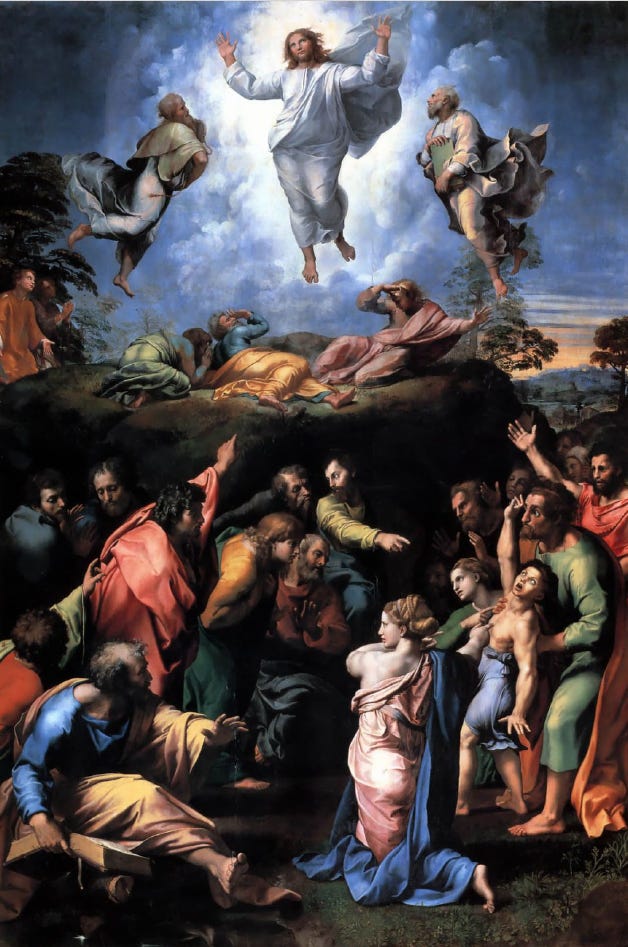Looking Up: How Raphael’s Transfiguration Taught Me to See Again
A Reflection on How I Found Myself in the Wrong Place
I’m on the outside looking in, finding myself in the wrong place. In my Catholic writing community, we wrote reflections on famous paintings. I don’t know anything about art or reflecting on it, but I found it rewarding. I chose The Transfiguration by Raphael (the image at the top of this post), a painting with two scenes in one: above, Christ in radiant glory; below, a crowd in turmoil, blind to the miracle above them. And I found myself in the wrong scene.
The Transfiguration by Raphael shows the patience of our Lord. As a father of four, I recognize the expression on the face of Jesus, looking up and away while his children run amok, making a mess of things. But, like a father, Jesus isn’t going anywhere. He is always there to guide us and provide the hope for ourselves to live a better way.
In many ways, the painting displays the chaos of humanity. The crowd ignores Jesus hovering in brilliant white, with the Kingdom of Heaven opened in the background. Instead, their eyes glare and fingers point at one another. An old, bearded man in red sits at the center, his head turned with his palms out, pushing away any blame from a woman’s stare. Indeed, a man, standing above her, looks down at the same old man in judgment.
Many others are distraught, like the two men on the left in the middle. They look down, avoiding the eyes of others. They hope for a better life, for better circumstances to come or perhaps for forgiveness for what they have done. They ignore Jesus, the hope of a savior that hovers behind them, surrounded by Moses and Elijah, glorifying the Lord who will soon be sacrificed for all mankind. Jesus is transforming to save them right before their eyes, yet they look away.
Three others point in the direction of the Lord. But did they see Him or just the Apostles—Peter, James and John—who lie below? The Apostles appear confused, being awakened after falling asleep instead of standing guard for the Lord.
The only person that definitely sees Jesus is a boy who looks up in excitement, pointing at Him. But the adults do not see Jesus and instead, are concerned with and in the chaos. It is here where Raphael demonstrates the words of Jesus: “Amen, I say to you, unless you turn and become like children, you will not enter the kingdom of heaven.” (Matthew 18:3)
I yearn for a spark of hope and excitement like those in the eyes of a child. If only I looked up, away from the chaos to see the brilliant white adorned by our Lord. Would I feel once again like a child in the womb, with its eyes closed? It is in that time that we are closest to our Father, a life just formed and with a pure soul.
If only I could remain gazing on the transfigured Jesus. Instead, I find myself all too often running amok, in the bottom of the painting, too concerned of things of this world. But there is hope! Just to the left of the Apostles, two men gaze at Jesus, one of them praying. It is no coincidence that Raphael placed them off in the corner, by the trees and away from the chaos.
I too must put myself in the right place and step away from the chaos, having placed too high a value on things of this world. I must be like the child, in the chaos, but not of the chaos, in order to see the Lord.
The Transfiguration by Raphael reminds us that even when we lose our way, the Messiah always stands glorified, holding the heavens open, inviting us back—not with condemnation, but with love. His presence is not above the chaos, but will take us through it, leading us home to the Father, the Son and the Holy Spirit.
Peace.


